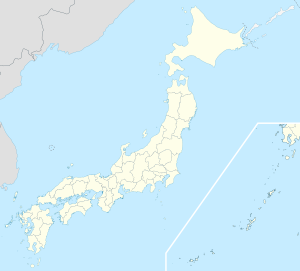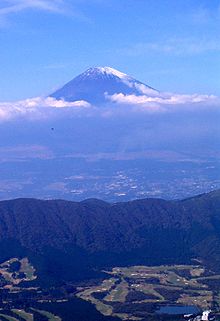Hakone (Kanagawa)
| Hakone-machi 箱根 町 |
||
|---|---|---|
| Geographical location in Japan | ||
|
|
||
| Region : | Kanto | |
| Prefecture : | Kanagawa | |
| Coordinates : | 35 ° 11 ' N , 139 ° 2' E | |
| Basic data | ||
| Surface: | 92.82 km² | |
| Residents : | 11,169 (October 1, 2019) |
|
| Population density : | 120 inhabitants per km² | |
| Community key : | 14382-1 | |
| Symbols | ||
| Flag / coat of arms: | ||
| Tree : | Prunus jamasakura | |
| Flower : | Pink hirtula | |
| Bird : | woodpecker | |
| town hall | ||
| Address : |
Hakone Town Hall 256 Yumoto Hakone - machi , Ashigarashimo-gun Kanagawa 250-0398 |
|
| Website URL: | http://www.town.hakone.kanagawa.jp/ | |
| Location Hakones in Kanagawa Prefecture | ||
Hakone ( Japanese 箱根 町 , -machi ) is a small town on the Japanese main island of Honshū in Kanagawa Prefecture , in Ashigarashimo County. It is about 100 km outside of Tokyo.
geography
Hakone is located in the mountainous foothills of Mount Fuji , in the middle of the Fuji-Hakone-Izu National Park . Nearby is Lake Ashi, surrounded by mountains and volcanoes .
The old Hakone border station on the historic Tōkai Road marks the transition from the Kansai region (literally: "west of the border station") to the Kantō region (literally: "east of the border station").
history
Hakone is the location of the famous Shinto shrine Hakone Gongen , which was mentioned for the first time in the Heian period (794–1185). During the Gempei War (1180–1185), Minamoto no Yorimasa prayed at this shrine for victory over his enemies shortly after his defeat in the Battle of Ishibashiyama in neighboring Manazuru . Like the rest of Sagami Province , the "Lower Ashigara Circle" ( Ashigara-shimo-gun ) and thus Hakone came under the control of the later Hōjō of Odawara during the Sengoku period (1477–1573) .
In the Edo period (1603-1868) Hakone-juku was a post office on the Tōkaidō highway between Edo (today's Tokyo ) and Kyoto and an official border post ( 箱根 関 所 , Hakone sekisho ) between the Kantō and Kansai region.
Here, under the Tokugawa Shogunate, all travelers on the Tōkaidō were stopped to check their travel permits and their luggage. Among other things, it was forbidden to carry weapons and women. At that time the area was already well known for its hot springs ( onsen ).
Parts of the post office were subordinate to the Bailiwick of Mishima, later Bailiwick of Nirayama (Nirayama daikansho) of the Shogunate domain . The rest of Hakone and the surrounding area belonged to the Principality of Odawara , like almost the entire district , which the Ōkubo ruled over from the beginning of the Edo period and then continuously from 1686 .
After the Meiji Restoration , Hakone and the district became part of the rather short-lived Ashigara Prefecture , which emerged from the Bailiwick / Prefecture of Nirayama and the Principality of Odawara , before it became part of Kanagawa Prefecture in August 1876 . In 1889, Hakone was granted city status, and the imperial family had a villa built as a summer residence on the lake shore.
With the incorporation of the two villages Motohakone and Ashinoyu on January 1, 1954 and the city of Yumoto and the villages of Onsen (Gora), Miyagino and Sengokuhara on September 30, 1956, Hakone reached its present-day expansion.
tourism
A considerable number of Japanese and international guests come to Hakone for relaxation, spa treatments or to visit the national park and the mountains. The people of Tokyo appreciate Hakone as a day trip destination to escape the hustle and bustle of the big city.
Like Odawara to the northeast, Hakone has many onsen (hot springs) and associated recreational facilities.
The Fuji-Hakone-Izu National Park , located around the Lake Ashi around, is a popular tourist destination. When the weather is cloudless and the view is clear, the view extends to Mount Fuji , one of the landmarks of Japan.
Another attraction is the volcanically active Ōwakudani ( 大 涌 谷 , large boiling valley ). In the mountains of Hakone there are numerous springs of hot sulphurous water; its smell is present in the whole area. The eggs cooked in it ( onsen tamago ) are said to bring a long life.
The lakeside Hakone Shrine with its red torii is another Hakone landmark.
"Pirate ships" operate on the Ashi Lake as scheduled boats for tourists. When the weather is nice in autumn, the lake is famous for its beautiful landscape with autumn forests in the background. In April, the offer cherry blossoms ( sakura ) and miscanthus ( Susuki ) a picturesque sight.
Museums
- Hakone Open Air Museum
- Hakone Museum of Art
- Lalique Museum
- Narukawa Art Museum
- Pola Museum of Art
- The Museum of The Little Prince
Special occasions
The annual Hakone Ekiden (a kind of long-distance relay race) at New Year's, runs from Tokyo to Hakone and back. It lasts two days and is partly carried out in memory of the historical Tōkaidō.
Partnerships
The Hakone Tozan Railway is a mountain railway in the style of the Rhaetian Railway in Switzerland . The two railways have had a friendship agreement since 1979.
Town twinning
traffic
- Street
- National Road 1 , to Tokyo or Kyoto
- National road 138
- train
- Hakone-Tozan Line from Odawara to Gōra
- Cableways
climate
- Average annual temperature: 16.9 ° C
- Maximum: 36.5 ° C
- Minimum: −0.7 ° C
- Annual rainfall: 1932.0 mm
(Data: Yokohama Local Meteorological Observatory, 2004)
Neighboring cities and communities
- Kanagawa Prefecture
- Shizuoka Prefecture
Web links
- Tourism information (English)
Individual evidence
- ↑ Regional Development Office Kantō of the MLIT: Tōkaidō Q&A, 箱根 が 宿 場 に な っ た の は い つ 頃 で す か?
- ↑ http://www.town.hakone.kanagawa.jp.e.ry.hp.transer.com/index.cfm/11,1289,49,183,html






